
|   |

|   |
Dhauli Kalinga Mahotsav 2022 - Tapati Chowdhurie e-mail: tapatichow@yahoo.co.in Photos: Odisha Tourism April 6, 2022 The spectacular Dhauli Kalinga Mahotsav showcasing classical dance, martial art forms and folk performances, with more than 500 artistes taking part, at the foothills of Dhauli with the impressive Peace Pagoda atop the hill offering a panoramic view, is Odisha's pride. It takes place in the beginning of February, but in 2022 when people had almost given up the idea of enriching themselves with this yearly cultural extravaganza, the organizers decided to celebrate it in the third week of March. The three day long cultural extravaganza consisted of Manipuri, Odissi, Kathak and Bharatanatyam in the classical genres; in contemporary martial arts, Santosh Nair of Sadhya gave a glimpse of his sensitivity through his art form; Thang-Ta martial arts of Manipur by Huyen Lallong Manipur Thang-Ta Cultural Association provided a brief peep into the art form. Besides, there was Prahlad Natak -folk theatre of Odisha - by Gajendra Panda and group. A group tabla recital by Ninada of Pramod Sahoo made the audience sail through the colours of rhythm. 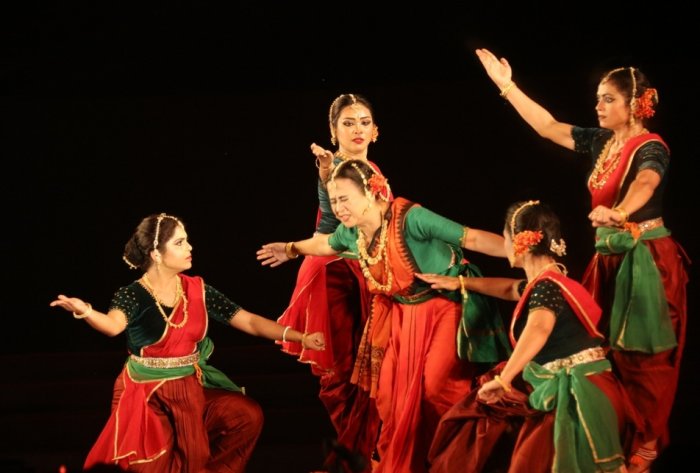 Bimbavati Devi & group The three day long program launched off with Manipuri Nartanalaya's presentation of 'Bhoomi.' The choreography was by Bimbavati Devi, daughter of stalwart gurus Bipin Singh and Kalavati Devi. She based 'Bhoomi' on Bhoomi Suktam -a hymn of 63 mantras from the 12th section of Atharva Veda devoted to Mother Earth, which are regarded as illustrations of environmental consciousness, composed 2500 years ago. The composition began with the episode of sacred Bhudevi who was kidnapped and hidden under primordial waters by demon Hiranyaksha. Lord Vishnu in the form of Varaha lifted her up from the cosmic water on his tusks and restored her position in the universe. After this the mantras of Bhoomi Suktam were used to describe the beauty and virtues of Mother Earth. She sustains life - of plants, animals and human beings. Oceans, rivers and lakes with its waves were described through the grace of Manipuri dance. The part where people misuse her only to later realize their mistake was emoted in a captivating manner. Besides this, the troupe performed 'Purna Purushottam' which was again about the greatness of Vishnu. In the Geeta, Bhagavan had himself proclaimed that whenever good is trampled by evil, he will come down to redeem mankind. Bhakta Prahlad thus was repeatedly saved by Bhagavan Vishnu, from the smouldering blazes of the demoness Holika and from the assault of his villainous father Hiranyakashipu. 'Purna Purushottam' was a celebration of Vishnu in the form of Narasimha. The melodies of the songs that were used in the choreographic piece were inspired by the traditional songs that are sung during Holi in Manipur. The songs used for the dance was spectacular. It was conceptualized by Bimbavati Devi, danced by Tanususree Das, Kankana Singh, Ivana Sarkar, Sananda Chakraborty and Bimbavati Devi to the music composition of Romila Devi, R.K. Upendra Singh and Bimbavati Devi. 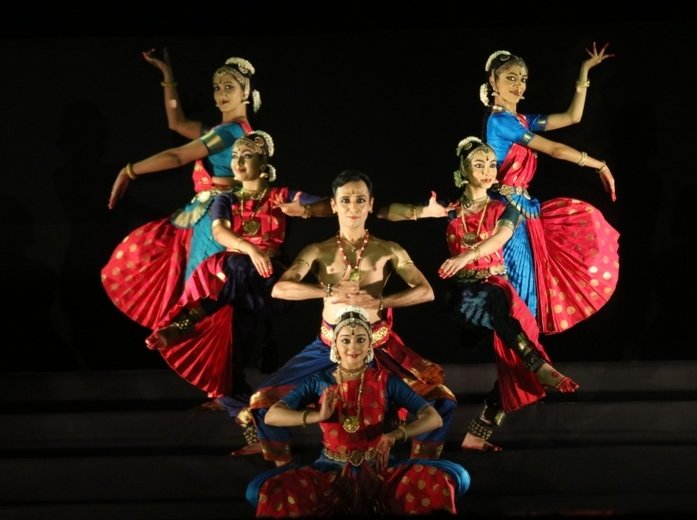 Praveen Kumar & group Bharatanatyam performer Praveen Kumar, a disciple of Guru Narmada, paid his guru the best honour a guru deserves, through his flawless performance with his Chithkala group. Praveen Kumar and his team of well trained dancers performed traditional items. Pushpanjali was an invocatory piece offering obeisance to Ganesha, Lakshmi and Shiva through pure nritta interspersed with shlokas praising them with devotion. Krishnanjali eulogised the activities of Lord Krishna, starting from getting his ears boxed by his mother for eating mud and subsequently seeing the 16 dimensions when Krishna opens his mouth at mother Yashoda's bidding. In the sanchari part, Praveen as Vamana (Vishnu in the guise of Vamana) humbling king Bali was done evocatively. The dwarfish Vamana covering the entire world and the sky with two steps and pushing King Bali to the nether world, was a story well told through the vocabulary of picture perfect Bharatanatyam. In the course of the story the music meandered through many ragas. It was a listener's delight, a composition of Saint Purandaradasa. Kuntalavarali Thillana rounded off his presentation. The joy of rhythm permeated and spread all around creating beauty and joy. The dancers Shreema Upadhyaya, Divya Hoskere, Navyashree, Siri Chandrasekhar, Nidhi Seshadri along with Praveen gave the audience pure delight. 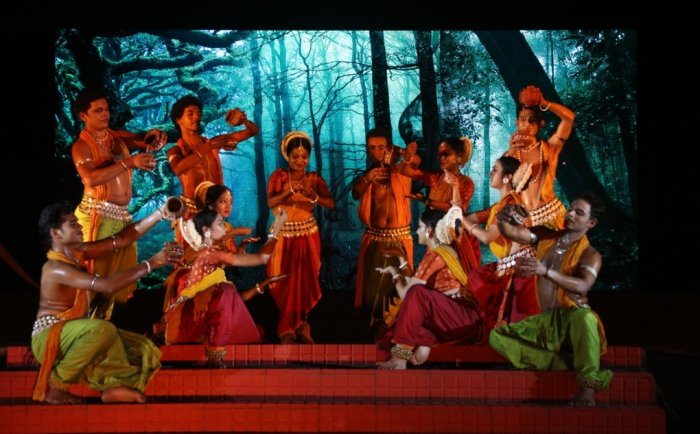 Aruna Mohanty's group On the last day of the festival, Orissa Dance Academy's 'Ashara Kirana' conceptualized and choreographed by Aruna Mohanty told the story of SCB Medical College - the premier medical institution of Odisha -an offshoot of Maratha Vaidyashala which mainly treated pilgrims visiting Jagannatha temple of Puri and how it became a medical school to treat British sailors and locals. It touched upon the fact of its becoming - after the independence of India - a reputed college and a premier hospital. Remarkably the choreography covered Odisha's 200 years of social history. The hospital has always served the people of the region during their times of distress, starting from the terrible famine of 1866 to the present times, when the world is in the grip of Covid. In covering this 200 year old history, it has also covered its cultural history. Bada Medical College was personified in a beautiful poem where it says that it is a symbol of the heritage of Odisha and stands as a sentinel watching over the two century old history of the State. She has chronicled its struggle and success. She narrates her happy story of what she has witnessed. Aruna Mohanty has used classical Odissi, gotipua and the folk dances of Odisha to make 'Ashara Kirana' a composite whole. Her innumerable well trained students played their parts most satisfactorily. It was presented with the joint effort of Orissa Dance Academy, Bhubaneswar and Mokshya of Cuttack. The dancers were Dr. Siddharth Mohanty, Madhusmita, Sreepunaya, Suchismita, Sandhyarani, Sheetal, Sayani, Prapti, Bhumika, Shruti, Saynal, Preeti, Soumya, Shikta, Vijayita, Ananya, Saptapadi, Santoshi, Suvangi, Pratap, Niladri, Binayak, Himanshu, Diptiranjan, Subham, Chinmay, Bhimsen, Aditya, Sunil, Abhiram, Arupananda, Ahok, Biswajit, Mana, Deepi, Deepa, Swati , Rajashree , Ankita, Dullari, Sudha, Raja, Ranjit, Jitu, Chintu, Rishi, Kunal, Sarukh, Pradeep, Soumya, Asutosh. Modern dance was choreographed by Md. Shafiul Haque. Accompanying musicians were Agnimitra Behera on the violin, Dhaneswar Swain and Ajay Kumar Chaudhury on the mardala, Matru Prasad Das on vocal, Srinibas Satpathy on the flute, Rabishankar Pradhan played the sitar. Other artistes who also accompanied were Ramesh Chandra Behera on the keyboard, Bhabotosh Mohanty on guitar, Nazia Alam on vocals. Script was by Kedar Mishra. The dance-drama was directed by Guru Pabitra Kumar Pradhan and Bijan Kumar Palai. 'Ashara Kirana' was a gem from the collection of Aruna Mohanty. The Kathak presentation of Urvashi Dance and Cultural Society's presentation in this august venue could have been better. 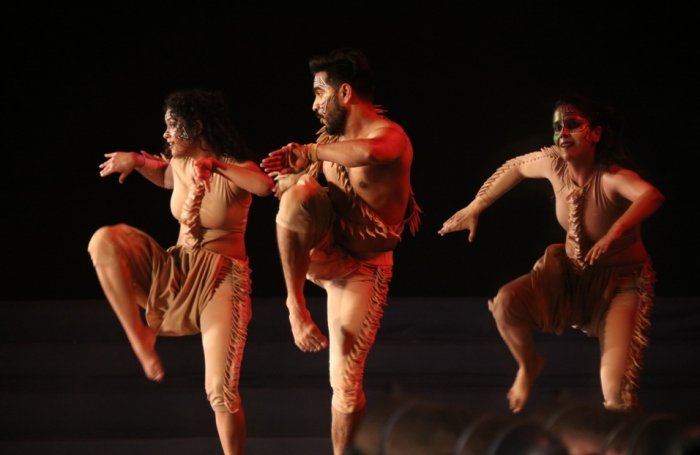 Santosh Nair's group Santosh Nair is adept in both traditional Kathakali and Mayurbhanj Chhau. He's trained in Contemporary dance form as well. His 23 year old dance company Sadhya has been producing experimental and innovative choreographic work. The company has carved a niche for itself as a bridge between tradition and modernity. He is a rare artiste who is famed for his out-of-the-box thinking. His presentation at the Mahotsav was 'Mystical Forest', in which he has explored life within the forest. In his production he has used Mayurbhanj Chhau, with strong grounded movements and contemporary interpretation. Varied experiences, activities, emotions, relations and rituals of the forest inhabitants have been incorporated in the production with discernment and accuracy. Its music and dance compositions, movements, use of light and costume have created a natural forest replete with its inhabitants. It is a different world altogether, at times apprehensive of outside disturbances. The message of 'Mystical Forest' is a plea to mankind to leave the forest dwellers to be as they are for both their good and our good. Choreographer Santosh Nair and composer Upamanyu Bhanot did more than justice to the script of Nalini Sharma. The lights man Milind Srivastava created the right forest ambience blending perfectly the costumes - by Alpona and Neeraj - of the animals with the surroundings. Dancers Santosh Nair, Sudhir Kumar, Neha Sharma, Himesh Parcha, Sahul Bhatia, Swati Shishodia, Pankaj Singh, Priyanka and Mahi Sharma were in peak form. The stylization of the presentation, influenced by Chhau dance, was awesome. 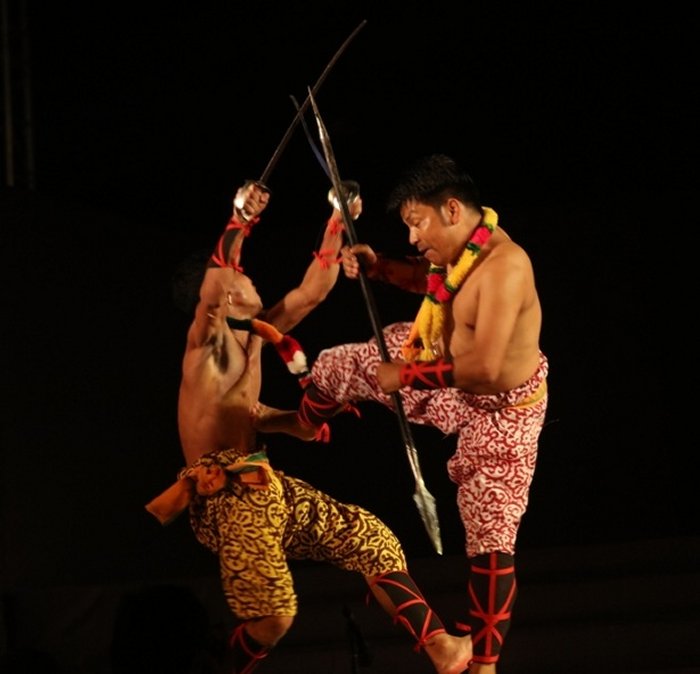 Thang-Ta Thang-Ta, the Manipuri art form used for both self defence and offence with a deep spiritual foundation and a long historical tradition right from pre-historic times was performed by Huyen Lalong Manipur Thang-Ta Cultural Association. The first piece 'Thang Leiteng Haiba' performed by H.Indu Devi and Silparani Devi is a shortened version for the stage. It is usually meant for wars. The second piece Thang-Ta Chainaba was by Sh. Abung Sharma and N. Nishikanta Singh. Here the swordsman used two swords while the spearman used one spear. In the piece they attacked as well as defended themselves. It was used to capture wild animals. 'Cheirol Jagoi' was a stick dance. The dancer held 3 sticks of different sizes and danced with different steps in a speedy style enthralling spectators. Then followed a duel combat with swords. Interestingly the next number was a fight between two men with daggers in a ballet style. The style of fighting reached its height of excellence in artistry much to the delight of spectators. 'Thabi Kakpa' or cucumber cutting showed the skill of an experienced martial artiste, N. Rajen Mangang in this case. The artiste was blind-folded with a piece of cloth and sawdust. He cuts a cucumber placed on the belly of a man lying down. The audience watched holding their breath. 'Thang Ahum Yannaba' showed the fight of one man against two. G. Bisweswar Sharma, H. Indu Devi and S. Kamala Chanu were the performers. In this one swordsman handled swords in both hands and contests with two experts who held sword and shield. The single swordsman danced in exciting steps so as to cover himself from possible attacks with two swords and tried to attack the two experts. According to Thang-Ta expert Bireswar Sharma, the leader of the group, the art of Thang-Ta is an austere art demanding extreme discipline, courage, and ethics. 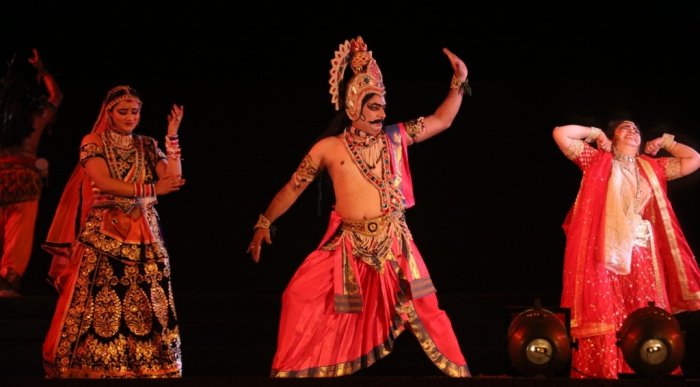 Prahlad Natak Guru Gajendra Panda, besides being an Odissi dancer of Debaprasad Das style, is adept in folk art too. His Prahlad Natak told the story of Raja Hiranyakashipu coming in a procession with his Senapati; when he approached Ganjam Jilla, "khadga ka khel" was being shown. They sang in praise of the Raja and genuflected to him. The Raja himself a devotee of Shiva Shankara worshipped his ishta devata, singing "Hara Hara Shiva Shankara, Gauri Bara Gauri Bara", in Sabdaswara pata. The drama progresses when Bhakta Prahlad, the son of Shiva Bhakta King was singing in praise of Vishnu -"Chintana hrudayakari Hari Shri Hari Hari mukhare namauchari". The Raja tells his son to sing the praise of Shiva Shankara and not Vishnu. As Prahlad refuses to obey his father, he is sent away to the jungle with instructions to be killed. Hearing the chanting of Vishnu by Prahlada the animals are filled with devotion and they befriend him. When Prahlada comes back safe from the jungle, his mother Lilavati's happiness knows no bounds. But the angry father calls the Khadgadhari Veer to kill his son. He too goes away on hearing the chanting of Narayana. The infuriated Raja throws his sword at his son only to be saved by his mother Lilavati. The Raja then orders Agni to burn him to ashes but Prahlad comes out unscathed. "Where is your Hari? He says he is everywhere, He is Bhagavan. Show me if he is in this pillar," demands the Raja. In a fit of rage the Raja hits the pillar hard with his mace and out comes Narasimha - an avatar of Vishnu - striking him dead. The musicians were from original Prahlad Natak of Ganjam District. Music Guru Ramahari Das and rhythm Guru Dhaneswar Swain were able to bring out the essence of the piece. Dr. Shantanu Kumar Rath was the script writer - the original script however was by Raja Ramakrishna Chotray of Jalantara. Prabhutosh Panda was in the role of Hiranyakashipu. Madhubrata Mohapatro was Prahlad, Dipika Priyadarshini was a typical mother out to save her son. And of course choreographer Guru Gajendra Panda was Narasimha. 'Gajakarna Bira' was enacted by Dipak Sahoo and Binod Chandra Sahoo. Dikshya Singh, Ritika Banerjee, Sreya Sradhanjai Das, Vidhi Sengupta, Tejashri Jena, Binodini Nayek, Harapriya Sahu, Preeti Nandini, Khirabdhi Mohapatro and Aarya Nande were the other participants. Khadga and Agni Danda were by Rajesh Kumar Behera, Shantanu Kumar Rout, Balabhadra Sethi, Sambit Kumar Mangaraj, Ashish Kumar Mohanty, Durga Prasad Barik. Vocalist Santosh Kumar Satpathy, sutradhara Kanhu Charana Sadangi, mardala player Kaliya Bisoyi, mukha vina player Dharma Barik, dhol player Ramchandra Behera, violinist Pradip Kumar Maharana, dhuka artist Lambodar Mahanta were the accompanying artistes.  Tapati Chowdurie trained under Guru Gopinath in Madras and was briefly with International Centre for Kathakali in New Delhi. Presently, she is a freelance writer on the performing arts. |